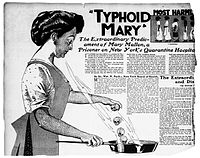
Photo from wikipedia
BACKGROUND Much remains unknown regarding the evolution of SARS-CoV-2 seroprevalence and variability in seropositive children in districts, schools and classes as only a few school-based cohort studies exist. Vaccination of… Click to show full abstract
BACKGROUND Much remains unknown regarding the evolution of SARS-CoV-2 seroprevalence and variability in seropositive children in districts, schools and classes as only a few school-based cohort studies exist. Vaccination of children, initiated at different times for different age groups, adds additional complexity to the understanding of how seroprevalence developed in the school aged population. AIM We investigated the evolution of SARS-CoV-2 seroprevalence in children and its variability in districts, schools and classes in Switzerland from June/July 2020 to November/December 2021. METHODS In this school-based cohort study, SARS-CoV-2 antibodies were measured in primary and secondary school children from randomly selected schools in the canton of Zurich in October/November 2020, March/April 2021 and November/December 2021. Seroprevalence was estimated using Bayesian logistic regression to adjust for test sensitivity and specificity. Variability of seroprevalence between school classes was expressed as maximum minus minimum seroprevalence in a class and summarised as median (interquartile range). RESULTS 1875 children from 287 classes in 43 schools were tested, with median age 12 years (range 6-17), 51% 12+ vaccinated. Seroprevalence increased from 5.6% (95% credible interval [CrI] 3.5-7.6%) to 31.1% (95% CrI 27.0-36.1%) in unvaccinated children, and 46.4% (95% CrI 42.6-50.9%) in all children (including vaccinated). Earlier in the pandemic, seropositivity rates in primary schools were similar to or slightly higher (<5%) than those in secondary schools, but by late 2021, primary schools had 12.3% (44.3%) lower seroprevalence for unvaccinated (all) subjects. Variability in seroprevalence among districts and schools increased more than two-fold over time, and in classes from 11% (95% CrI 7-17%) to 40% (95% CrI 22-49%). CONCLUSIONS Seroprevalence in children increased greatly, especially in 2021 following introduction of vaccines. Variability in seroprevalence was high and increased substantially over time, suggesting complex transmission chains.
Journal Title: Swiss medical weekly
Year Published: 2023
Link to full text (if available)
Share on Social Media: Sign Up to like & get
recommendations!